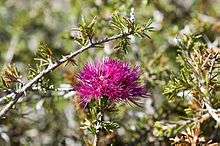Beaufortia puberula
Beaufortia puberula, commonly known as hairy-leaved beaufortia, is a plant in the myrtle family, Myrtaceae and is endemic to the south-west of Western Australia. It is a shrub growing to a height of about 2 m (7 ft) with hairy young leaves and heads of hairy, pink or red flowers during most of the year.
| Hairy-leaved beaufortia | |
|---|---|
 | |
| Scientific classification | |
| Kingdom: | Plantae |
| Clade: | Tracheophytes |
| Clade: | Angiosperms |
| Clade: | Eudicots |
| Clade: | Rosids |
| Order: | Myrtales |
| Family: | Myrtaceae |
| Genus: | Beaufortia |
| Species: | B. puberula |
| Binomial name | |
| Beaufortia puberula | |
| Synonyms | |
Description
Beaufortia puberula is a shrub which grows to a height of 2 m (7 ft), sometimes spreading to 2 m (7 ft) wide. The leaves are arranged in opposite pairs and are 1.5–4 mm (0.06–0.2 in) long, 1–1.5 mm (0.04–0.06 in) wide and hairy, or hairy when young.[2][3]
The flowers are pink or deep pink to red and are arranged in heads on the ends of the branches. The flowers have 5 sepals, 5 petals and 5 bundles of stamens. The stamen bundles are about 1–3 mm (0.04–0.1 in) long with 5 to 7 separate stamen filaments a further 1–2.5 mm (0.04–0.1 in) long. The inner surface of the bundles is glabrous but the outer face in covered with long hairs. Flowering occurs in most months and is followed by fruit which are woody capsules 10–16 mm (0.4–0.6 in) long and about 5 mm (0.2 in) in diameter, joined in clusters.[2][3]
Taxonomy and naming
Beaufortia puberula was first formally described in 1852 by Nikolai Turczaninow and the description was published in Bulletin de la Classe Physico-Mathématique de l'Académie Impériale des Sciences de Saint-Pétersbourg.[1][4] The specific epithet (puberula) is derived a Latin word meaning "downy".[5] The species had previously been known as Beaufortia interstans.[2]
Distribution and habitat
Hairy beaufortia grows in sand, sometimes with laterite or loam and occurs near Merredin, Katanning and Southern Cross in the Avon Wheatbelt, Coolgardie, Geraldton Sandplains, Jarrah Forest and Mallee biogeographic regions.[3][6]
Conservation
Beaufortia puberula is classified as "not threatened" by the Western Australian Government Department of Parks and Wildlife.[3]
References
- "Beaufortia puberula". APNI. Retrieved 26 July 2016.
- Burbidge, Andrew A. (2016). "A taxonomic revision of Beaufortia (Myrtaceae: Melaleuceae)". Nuytsia. 27: 191–193.
- "Beaufortia interstans". FloraBase. Retrieved 26 July 2016.
- Turczaninow, Nikolai (1852). "Myrtaceae Xerocarpicae in Nova Hollandia a cl. Drummond lectae et plerumque in collectione ejus quinta distributae, determinatae et descriptae". Bulletin de la Classe Physico-Mathématique de l'Académie Impériale des Sciences de Saint-Pétersbourg. 10: 345. Retrieved 26 July 2016.
- Brown, Roland Wilbur (1956). The Composition of Scientific Words. Washington, D.C.: Smithsonian Institution Press. p. 392.
- Paczkowska, Grazyna; Chapman, Alex R. (2000). The Western Australian flora : a descriptive catalogue. Perth: Wildflower Society of Western Australia. p. 349. ISBN 0646402439.